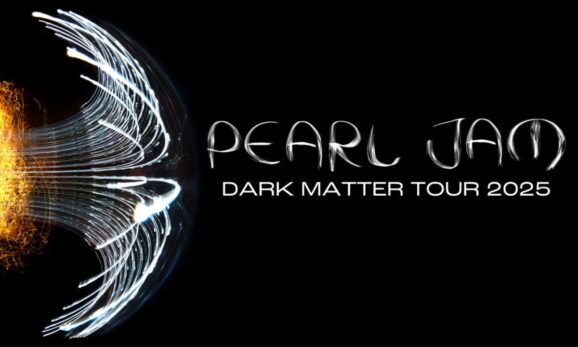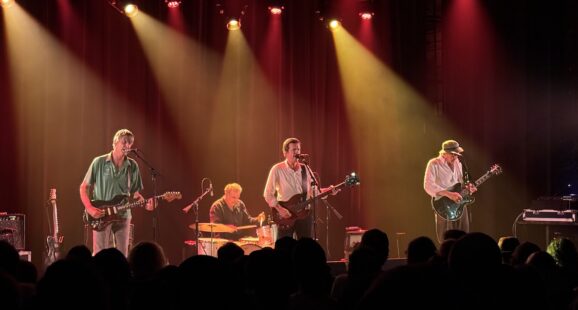Much of the character of the modern world—and the source of many modern problems—stems from disparate things bumping together: borders, clashes of civilizations. And toxic pollutants and cleanliness.
Such were the ideas that drummer Paul Derricott chose to explore via metaphor in his prog jazz outfit, COAST, on their new album, Ember. He wondered, “What happens when dense compositions bump up against free-wheeling improvisations?”
We talked to Derricott on Zoom from his home in Sydney, Australia, where he confirmed that the spiders down under are as terrifying as we see on the interwebs (even if he talked about them in the chill way only a native can). Derricott wears many hats. He’s a composer. A drummer who has worked with Lanie Lane, the Beautiful Girls, Georgia Mooney, Aloe Blacc, Charenée Wade, and Lakecia Benjamin. A teacher who has drumless versions of his tunes available on Bandcamp. And a father who had just returned from an event, prior to our talk. “We had an Easter hat parade today up at my kids’ school. It’s sort of a craft fest where we glue little baubles onto funny hats, and the kids walk around in circles.”
So, he’s taking time to live life in the midst of his work. All of this comes into play with COAST, truly a collaborative company, even if he is clearly the CEO.
The following interview has been edited for length and clarity.
How did you first start playing drums?
I started on the saxophone and did that through the primary school, which is up to about the age of 12. When I went to high school, I wanted to play in a rock band, like Nirvana or something. So, I played the drums. And that was the start of it for me. I decided I didn’t want to play the saxophone, because you can only play jazz on the saxophone. And then as I got more into it, I was more interested in, you know, the people that I started listening to. There’s lots of great musicians in Australia. There were some great punk bands in my area. And then we’d get we catch touring artists coming over from the States. Primus came out, Tool came out on the Ænima tour. And then when I sort of found out more about those guys, they’d talk about jazz drummers. Then I sort of started checking out jazz, local jazz guys that could really play.
How did you go from wanting to be in a rock band and listening to jazz to actually playing jazz?
I got really interested in improvising and the American tradition of jazz. I think of jazz as predominantly an American art form. But growing up in Australia, you can’t miss AC/DC. You just can’t. It’s just the background to so much music. Even if you’re not a big AC/DC fan, you can’t miss it over here. It’s a huge part of the music. And same with Cold Chisel. It’s what I remember driving around in the backseat of the car with my parents. Then I went to New York and hung out and did that. I think to come back to play sort of some of that language and some of that concept, that expedition style music where you’re trying to improvise and you’re trying to sort of create the whole time and be spontaneous and on a form is really important to me. But having the backbeat in there is really attractive. I love the compositions of Wayne Shorter. And I love the backbeat on “Highway to Hell.”
Somewhere in between those things is COAST.
Maybe. I’d love to think that.
You wanted to be in Nirvana, but not Silverchair? They must have been huge there during the era when you were really into rock.
Silverchair definitely was a big, big deal. I went and saw Silverchair when I was a kid. They may be a couple of years older than me. Not much at all, if anything. That was a big deal for sure. But I’d also go see them and get into the support band. Maybe I wanted to be in Silverchair so much, I couldn’t bear to witness it (laughs).
There’s a piano sitting there behind you. Given that you’re the composer for COAST, I assumed you play other instruments besides drums. You play piano, you play drums, you play saxophone. Any other instruments?
Yeah, a little bit of campfire guitar. I wouldn’t perform on it, is what I what I’m saying, but I’ll write on guitar or piano or saxophone and sort of make the demos. Or, you know, I’ll compose the piece and record it on any of those instruments, sort of depending on what I’m interested in mucking around on. So, yeah, I can play those instruments but I can’t perform on them. I can noodle around and come up with ideas.
That’s the process. I write all the stuff for COAST. And the tenor saxophone is the thing that I play. I like that because it’s a similar range to my singing voice. I think that I’ve always had an affinity with that, which is why I have tenor saxophone in the band. Normally, the melody comes first. Either the drums or the melody are definitely sort of the inspiration of the piece. And then I’ll sort of flesh it out on another instrument, piano or the guitar to sort of fill it out, depending on what I’m thinking about at the time. It’s sort of like a little bit of a mad cooking experiment or something, where I’m trying to maybe play the drums for a bit and then record it a little bit and then play some saxophone and maybe play on the piano a little bit.
Then do you chart it out for the other guys in the band?
Yeah, then I’ll write it out. Normally, I’ll write the chart as well as I go, sort of. The way the band formed was that I’d written a bunch of music. And then I rang up some friends. I had an idea of having a play with some people, not really forming a band. And the guys that are now COAST, Shannon (Stitt), Michael (Avgenicos), and Pete (Koopman) were all really generous with their time and we just made a regular get together once a week. But compared to what I’ve written, they really fill in the details for the final project. They’re very generous with their input and their creative direction. Those guys are really key to the band.
Tell me a little bit more about the process for Ember.
There’s a composer and bass player, a Sydney guy, Jonathan Zwartz. He’s actually a New Zealander. Great composer. And I listen to his records a lot. And they’re beautifully written, beautifully recorded. It’s sort of a collage or a quilt, sort of, but a very beautiful structure that has all these little fine details sprinkled over the top of it. And when you listen to it with headphones on, there’s sort of these shifting sands that keep you really interested. I love his records. The aesthetic is a different thing to me, though. I think if you listen to his music, you might go, I don’t hear that aesthetic at all in COAST. It’s sort of like a much gentler music. And I think part of it—the title track, anyways—is an attempt to sort of create like a composition that sort of unfolds in a in a slightly unusual way, feels a bit more through composed and then has some details that sort of sort of keep you listening through the thing as an experience.
A lot of that particular track was written in lockdown. We didn’t get to play for a long time as a group. And then, post-lockdown, it was quite hard initially to get everyone together. And, you know, playing very poorly funded jazz was not high on anyone’s list. Not even mine, you know. We would get together and record a couple of songs at a time. They’d be just the three compositions that I’d written. I’d book a day in the studio; we’d record them. I would come home, and we would overdub some guitars at my house, or Shannon would maybe do some synthesizers at his place. I guess it was just sort of a meditation on those past couple of years, trying to commit to being vital and continuing to search for interesting things to do. The idea of the album is to keep that flame of creativity. It feels a bit futile sometimes doing this stuff, if I’m brutally honest about it. There’s so much crazy stuff going on in the world, all the time. And I’m writing songs about places that I reflect on in this sort of whimsical way. It feels a bit pointless, but when I reflect on it, I think it is really vital to me to keep sort of trying to offer stories and reflections on where I am and what’s around me.
Like “Kyeemagh,” which was the first single we put out, is the name of a beach not far from my place. We went in lockdown. We weren’t allowed to go. We were limited geographically by how far we could go from our homes. One of the things that I do a lot is I swim. It’s like a mental break. You know, just keep swimming. But you couldn’t go to the pool, couldn’t do any of that sort of stuff. So I went to swim at Kyeemagh, which is at the end of the Cooks River. Kyeemagh is the indigenous name. It feels like this tension, this beautiful place that has this horrific history on the end of the Cooks River, which is one of the most polluted waterways in Australia. But it’s a beautiful spot in a way, and that that tension that I feel in those places, I think it’s worth reflecting on. I don’t want to be prescriptive as to how you think about it, but I think they’re interesting things to think about and I want to continue to share them. So that’s the thrust of the album and why I’m continuing to do it.
Listening to your album Live 2023, I was struck that the songs seem jammier. Is that fair to say? I assume it’s because you’re playing live?
Absolutely. I love listening to that type of music. I think maybe moving forward, I’m just going to record compositions. Three minutes of just the song that I write. And then, like, six months later, put out a live album of us playing it for 20 minutes, something like that. I’m not sure. Sometimes splitting the difference makes it not as good, either way.







